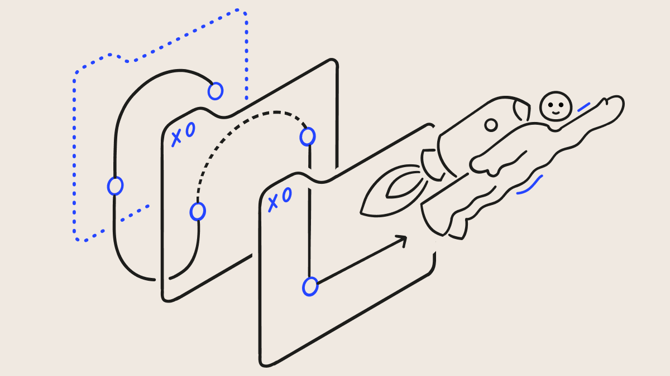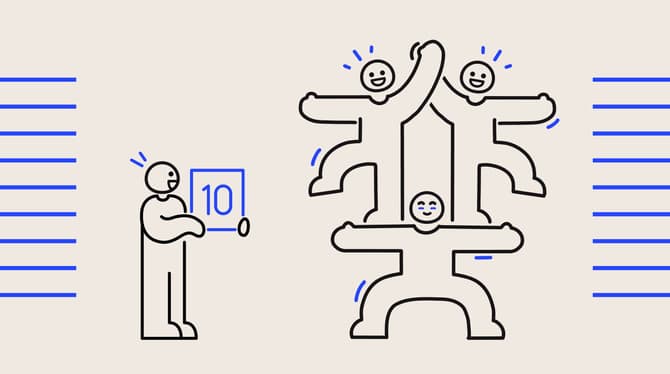Performance management is like a GPS for managers and employees — a handy system that continually helps track employee progress, navigate roadblocks, and recalculate when necessary, swiftly leading to the destination of improved individual and company performance.
In the past, performance management was centered around an annual review that judged how well an employee performed that year and how many goals they met. This system is increasingly being phased out, as some argue it demotivates employees by focusing more on what they did last year than improving their current and future performance for the good of the organization.
Instead, managers are now complimenting this traditional method with performance management, which centers on learning through regular, informal conversations with employees about their performance. This dynamic approach has companies, teams, and employees reaping the benefits.
Exclusive online summit
·
May 23 2024
Moments that matter: how to seed great work
Here's all you need to know about what performance management is
What is performance management?
Briefly put, performance management is a year-round conversation between a manager and an employee about their job performance and how they can improve and continue to sharpen their skills.
This ongoing process aims to boost individual performance and productivity by setting clear goals, measuring progress, providing feedback, training, and coaching, tweaking areas of improvement, and recognizing achievements.
Done right, performance management creates and sustains improved employee (and consequently company) performance, fostering an environment in which both can thrive.
⚡Performance management is undergoing a major transformation. Read more about where the method is heading and how leaders can use it to boost employee engagement and bolster career development.
Why performance management is important?
Performance management is a leavening agent, helping organizations (and everyone in them) rise to their full potential by improving performance all-round. It drives success by setting expectations, ensuring team alignment, and providing structures for managing, tracking, and evaluating employee performance.
A successfully implemented performance management system cuts down on time-consuming micromanagement, providing a vital blueprint for measuring your employees’ performance and identifying areas where they can benefit from improvement and training. With an effective performance management program, managers can understand what their employees are doing and how and why they’re doing it. On the flip side, employees will know exactly what’s expected of them on a daily, weekly, and monthly basis. They’ll also be aware of how their performance is assessed and what they need to achieve to move to the next level.
In addition to this, an effective performance management system leads to:
- Better goal alignment: Setting aligned team objectives is more than just informing employees about the organization’s bottom-line goals. It encompasses individual, team, and organizational objectives in a way that encourages employees to work both individually and collectively toward them.
- Increased employee engagement and productivity: Providing regular feedback and recognition can lead to more motivated, engaged, and productive employees. In fact, one Gallup study shows that engaged employees are 18% more productive than their disengaged counterparts and their companies are 23% more profitable, too. Simply put, engaged employees are more motivated and eager to come to work every day.
- Improved managerial leadership: Consistent feedback and guidance also offer you the opportunity to routinely boost your coaching and mentoring skills. Plus, it helps develop employees’ skill sets, molding them into the company’s next generation of leaders and creating a circular system of knowledge-sharing within the business.
- Better talent retention: Employees who have frequent performance meetings and training sessions with their managers are statistically more likely to stay with a company (as in the case of Adobe, which managed to cut its involuntary turnover by up to 30% through its frequent check-in program).One of the main reasons for higher retention rates is down to incentivization; if employees know you’re working hard to develop them professionally, help them reach their goals, and reward their good performance, they’re more likely to stay with the company.
- Improved organizational performance: Helping your employees learn, develop, and perform better has a positive knock-on effect on a company’s performance, increasing revenue growth and improving customer satisfaction. Consistent monitoring of performance and skill sets can also unearth potential performance gaps within an organization, which can be addressed to strengthen its competitive edge and improve its performance.
The performance management cycle
Managing employee performance is a constantly evolving process, changing with the needs and requirements of employees, the organizations they work for, and the customers they serve. In this way, performance management can be seen as a continuous process of developing, monitoring, measuring, and evaluating performance, constantly working to align the success of employees with that of the organization.
The performance management cycle typically involves six key stages:
1. Planning
Performance planning helps set and manage expectations. The most effective ones include timelines and goals that are well-defined, measurable, attainable, and relevant — helping employees understand what needs to be done, why it needs to be done, by when, and the level of effort required. For better alignment, you could involve your employees in the creation of their own performance plan by discussing with them their responsibilities, performance standards, and developmental objectives. This helps employees visualize their path forward and allows senior management to identify training opportunities.
2. Monitoring
Monitoring and measuring an employee’s progress using key performance indicators (KPIs) is important to understanding whether or not they’re on the right track. Frequent check-ins, evaluations, and continuous feedback will help channel their efforts toward achieving company objectives and will alert you to any interventions that should be made before they become larger issues.
Helping teams set short- and long-term goals is a key part of improving employee engagement, boosting team performance, and empowering your employees to reach their full potential. With an Objectives and Key Results (OKRs) framework, you can help drive accountability and continuous alignment throughout your organization.
3. Developing
This stage involves working with employees to develop plans and strategies to address areas of improvement. Whether it’s by providing training and development opportunities, coaching, or mentoring, development is a key step in helping your employees and your organization achieve new levels of success.
Tip: If you’re wondering how you’ll have the time to structure and execute formal professional development sessions, rest assured they’re not always necessary. Instead, you can picture employee development as an ongoing process of checking in on people's morale and identifying any challenges they’re struggling with. From there, you can help guide or redirect them to get them moving in a positive direction.
4. Rating
There are various ways of rating an employee's performance. You can go for a more structured approach, basing your review on the KPIs and other measures laid out in your performance plan. For this, you might assign a score of 1-5 or use a performance appraisal form to document an employee’s strengths, areas of improvement, and development goals.
Alternatively, you can tackle it collaboratively, breaking each goal up and inviting your employees to describe how well they feel they did. This two-way approach can help build a greater sense of trust and mutual understanding between you and your employees.
5. Rewarding
Providing individual team members with recognition, bonuses, and promotions for a job well done doesn’t just fill them the boots with pride, it also incentivizes them to perform better. According to Deloitte, employee recognition programs experience a 14% improvement in employee engagement compared to those without these programs, leading to a 2% increase in profit margins and higher employee satisfaction.
You don’t need to wait till Christmas to reward employees. Pepper your people with praise and support throughout the year by trying different ways to increase recognition in your workplace.
6. Renewing
This final phase of the performance management cycle involves taking the insights gained in each stage and using them to continuously refine performance measures, revise goals and objectives, and update processes and procedures to ensure their ultimate effectiveness.
Best practices for solid performance management systems
Given that only one in five employees perceive their company to manage performance in a way that motivates them to do their best work, it’s clear that the whole performance management process is due for a revamp. Of course, different models will work for different organizations, but we’ve identified seven best practices that you can start implementing today to create solid, effective, fair, and robust performance management systems.
1. Set SMART goals and track results
Setting performance goals is easily one of the most crucial elements of an effective performance management strategy. They provide clarity and accountability, ensuring everyone’s on the same page about what’s expected from them.
But having goals without tracking the progress made toward them blunts their effect. That’s because monitoring results helps you accurately assess whether your employees are meeting the performance expectations set out in their goals. They also help identify any roadblocks or issues that may be impeding progress, enabling tweaks to be made as needed.
To maximize the meaningful impact of your goals, it’s a good idea to follow tried and true goal-setting guidelines like the SMART method, which prescribes that your aims be:
- Specific: Clearly defined goals, roles, and expectations provide employees with a springboard to success. Knowing what your priorities are (whether it’s employee retention, engagement, or otherwise) makes goal-setting a million times easier. It also makes employees aware of exactly what’s expected from them.
- Measurable: To remain fair and free from implicit bias, you can use objective measures like KPIs to evaluate performance rather than relying on subjective opinions that may not be fully informed.
- Attainable: It’s great when employees reach for the stars, but starting out with realistically achievable targets forms a solid foundation for success. It also helps prevent burnout, as employees' boundaries are working within what is accessible to them at that time.
- Relevant: Market conditions can change rapidly, so regularly revisiting goals to ensure the company's aims are in line with the rest of the industry is essential. It's also a good idea to frequently reassess your company's and employees' priorities to ensure they too are aligned.
- Time-based: Breaking larger goals into achievable sub-targets is like setting up road signs on the path to your goals: it helps keep employees on track and manages expectations about what needs to be achieved and by when.
But just because you’re setting goals doesn’t mean they’re set in stone. Managers know that, in business, challenges crop up and priorities change. That’s why it’s important for goals to remain adaptable. Targets that help individuals and organizations to stay focused on what is most important while being flexible enough to respond to the unexpected, foster individual and organizational resiliency and learning.
Never underestimate the power of impactful goals. Concentrate on simplifying the foundations of solid goal-setting with our comprehensive guide.
2. Meet with employees on a regular basis
According to Officevibe data, 70% of employees surveyed say they’d like to touch base more regularly with their managers. That’s because a continuous performance management process that includes frequent one-on-one meetings is very effective. They can give insight into an employee’s performance and help spot collaboration bottlenecks and goal misalignments.
Providing continuous, real-time feedback in this way can help employees solve issues before they become problems. Who doesn’t want that?
Tip: Officevibe’s one-on-one software helps you touch base with your team more frequently and efficiently with its intuitive and easy-to-use meeting tools and templates.
3. Promote transparent, two-way communication
Meeting often is great, but it’s about as useful as mitts on a snake if you and your employee aren’t communicating well. Transparent, two-way dialogues with employees not only make them feel happy and heard but also helps foster trust, engagement, and knowledge sharing.
To improve communication at work, managers can set up regular meetings with their employees and teams, encouraging everyone to express their thoughts and ideas in a safe, judgment-free space.
Of course, this is easier said than done. That’s why it’s a good idea to employ the help of anonymous feedback tools that can help facilitate honest discussions and establish a vital sense of psychological safety.
4. Make sure feedback is meaningful
Continuous, meaningful, and constructive feedback helps employees align their goals and expectations, learn, self-correct, and grow. That’s because timely feedback that’s development-focused and grounded in truth encourages employees to be more receptive to comments and suggestions. It also makes them more likely to try new approaches, fostering a more profound culture of learning and inspiring greater innovation.
That said, giving good feedback is just as important as receiving it. Listening to employees’ feedback and concerns could highlight blind spots or areas of improvement that you weren’t aware of — and addressing these issues promptly will deepen trust and respect within your team.
You could also involve teammates in the feedback process, encouraging them to provide one another with constructive comments. This will help you gain a more holistic view of your employees’ performance and understand their pain points, leading to even more meaningful feedback.
Providing constructive feedback is the cornerstone of strong leadership. Learn how to give feedback like a pro to drive employee performance and engagement.
5. Offer employee development opportunities
Mentoring employees and providing them with training and skill-building opportunities makes them feel like their company is invested in their success, which can strengthen their engagement and reduce employee turnover. In fact, so important is supporting employee growth that one study found that nearly one-third of tech workers said self-improvement through employee development or tuition reimbursement was their most-valued job characteristic.
To get started, you can set up a one-on-one meeting with your employees to chat about their individual goals and how their skills can be developed so they can reach their full potential. You can also discuss setting up a skills development plan that includes being challenged in a more senior role or expanding growth and knowledge through a lateral move to another team or department.
Professional development and career growth are instrumental in retaining your top talent around. Have the career development talk with your team members with the help of this tried and true template.
6. Focus on employee recognition
Praise, whether it’s in the form of a public announcement, a quick email, or a thumbs-up next to the office coffee machine, is worth its weight in gold. That’s because rewarding good performance motivates employees to keep it up and stick around. It also contributes to building a culture of recognition within a company.
But when it comes to cultivating recognition, the buck shouldn’t stop with managers. Encouraging colleagues to chime in with uplifting words for their teammates builds a sense of support and appreciation. And employees needn’t just be praised for their successes either; recognizing their effort (even if they don’t meet their targets) could help take the edge off their disappointment and spur them to try even harder.
💌 Highlight strong efforts and make peer-to-peer recognition easy with simple and fun tools like Good Vibes.
7. Use a performance management software
Enhancing performance management programs with the right technology can help facilitate feedback, plan meetings, track a team’s progress, identify areas of improvement, and maintain alignment — all in one place. This streamlines the performance management processes, positively affecting managers, employees, and organizations.
In fact, in a study conducted by McKinsey, 65% of respondents claimed their company’s adoption of software that supports performance management has had a positive impact on both employee and company performance.
A performance management system that drives business results
At the end of the day, performance management isn’t merely a tool for managing performance; it’s a fundamental process in a company. It enables managers to transform strategies into clear priorities and guides employees in where to focus their time and energy, ultimately improving organizational performance.
But beyond bettering a business’s bottom line, a solid performance management system is agile and adaptable and uses effective employee development software tools and methods that focus on people. It also ensures that employees understand their roles, receive constructive feedback, and have access to the support they need to do their best work.
In short, performance management is what gets employees rowing in the same direction to the best of their individual abilities, nurturing the environment of support, motivation, and inspiration that both people and businesses need to flourish.



